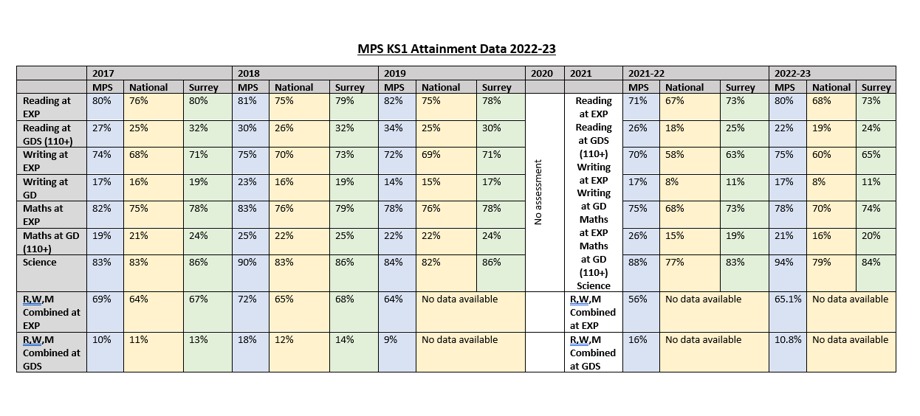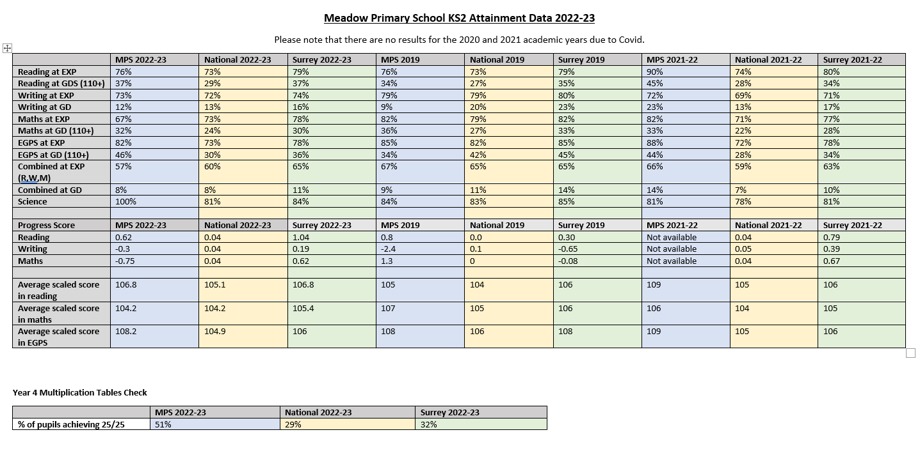School Performance and Results
The primary school performance tables provide information on the achievements of pupils in primary schools, how they compare with other schools in the local authority (LA) area and in England as a whole. Please note that due to the cancellation of national testing due to school closure during the 2019-20 academic year, there is no data available for this year.
The Department for Education Website - Meadow Primary School
The tables show:
- Results from the KS2 tests in Reading, Mathematics and Grammar, Punctuation and Spelling (GPS).
- KS2 teacher assessments in English, Reading, Writing, Mathematics and Science.
- KS1-2 progress measures in Reading, Writing and Mathematics.
- KS1-2 value-added.
Early Years Foundation Stage
The Early Years Foundation Stage (EYFS) sets standards for the learning, development and care of children from birth to 5 years old.
The prime areas are:
- Communication and language
- Physical development
- Personal, social and emotional development
The prime areas are strengthened and applied through 4 specific areas:
- Literacy
- Mathematics
- Understanding the world
- Expressive arts and design
A Good Level of Development (GLD) indicates whether a pupil has met the required standard in all 17 areas of the curriculum at the end of their Reception year.

Year 1 Phonics Screening Check
Year 1 pupils complete a national Phonics Screening Check at the end of Year 1. Pupils who do not reach the national expected standard at this time are given additional support and are re-tested at the end of Year 2.
SATS
SATS (Standard Assessment Tests) tests at primary school are taken at the end of Year 2 and Year 6. They are used to show your child's progress and attainment in school in comparison with children at the same age across the country.
Key Stage 1
SATs take place in Year 2 throughout May. Each child is teacher assessed in reading, writing (including spelling and handwriting), maths (including number, shape, space and measurement) and science. Your child's class teacher will set short pieces of work in English and maths to judge what level of ability your child is considered to be.
Key Stage 1 School, County and National Data
This data is based on teacher assessments of the pupils at the end of Year 2. It shows the percentage of pupils reaching the expected (EXS) standard in reading, writing and maths and the percentage who have achieved greater depth (GDS) which is well above the national standard.

Key Stage 2
SATs take place in May and more formal than Key Stage 1. The tests which are taken in Year 6 cover the three core subjects, English, Maths and Science. The papers are sent away to be marked with results being available before your child leaves primary school in July.
Key Stage 2 School, County and National data
SATs take place in May and more formal than Key Stage 1. The tests which are taken in Year 6 cover the three core subjects, English, Maths and GPS (Grammar, Punctuation and Spelling) The papers are sent away to be marked with results being available before your child leaves primary school in July. In addition, teachers assess pupils in writing and science.
Key Stage 2 School, County and National data
Attainment (average scaled scores):
Pupil results are reported as a scaled score, with 100 being the expected standard in each test. Scaled scores range from 80 as the lowest awarded, to 120 as the highest. A pupil achieving a scaled score of 100 or greater is working at or above the national expected standard in the subject. A score of less than 100 means a pupil may require additional support in order to reach the national expected standard. Further information on scaled scores can be found here: www.gov.uk/guidance/scaled-scores-at-key-stage-2
Average Progress:
Progress scores indicate the amount of improvement pupils make between Key Stage 1 and Key Stage 2. Due to the Covid pandemic, the Government has not released progress scores at school level for the Year 2021-22. These are expected to return for the 2022-23 academic year.
- A progress score of 0 means that the pupils in this school do as well at Key Stage 2 as they did in Key Stage 1. E.g. if a child reached the expected standard at Key Stage 1 and also at Key Stage 2, then this would be recorded as a progress score of 0.
- A progress score of less than 0 means that pupils did not do as well at Key Stage 2 as they did at Key Stage 1. This would be recorded as a negative progress score e.g -0.02 and a score higher than 0 indicates that the pupils have done better than they did at Key Stage 1.





